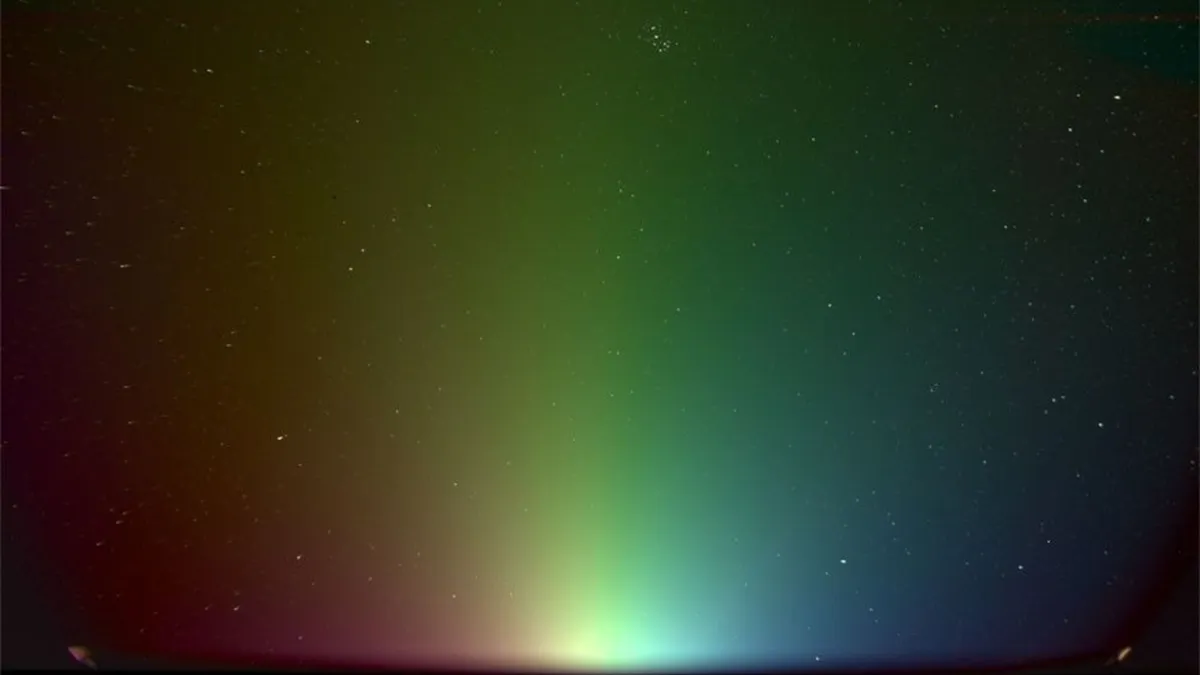
Nasa's newest spacecraft, aimed at studying the sun, has successfully captured a stunning colorful rainbow in the warm glow of zodiacal light observed above Earth. The PUNCH mission, which stands for Polarimeter to Unify the Corona and Heliosphere, was launched on March 11, 2025. This innovative mission consists of four small satellites working in unison in low Earth orbit, providing a comprehensive view of the sun's corona, or outer atmosphere, while also studying the constant stream of charged particles emitted by the sun, known as solar wind.
Recently, the PUNCH mission delivered its first set of breathtaking images, including a vivid, rainbow-colored view of the sky. According to a statement from NASA, these images prominently feature zodiacal light, which is the faint, diffuse glow produced by sunlight scattering off dust particles in space. In one striking view captured by the PUNCH mission's WFI-2 instrument on April 18, a hazy glow transitions from red on the left to green in the center, and blue on the right, all set against a backdrop of twinkling stars.
It's important to note that the coloration depicted in this image does not represent a true optical rainbow as seen by the naked eye. Instead, it is a colored representation of different wavelengths of light that showcases the instrument's ability to analyze various components of the solar atmosphere.
The PUNCH mission is pioneering in its approach to measure the corona and solar wind in three dimensions. This is achieved by studying the polarization of light, which refers to the direction light travels after being scattered by particles. The four satellites include one Narrow Field Imager (NFI), designed to block out the bright light from the sun, allowing for better visibility of details within the corona. On April 27, the NFI instrument captured a remarkable image of the new moon passing by the sun, utilizing its occulter to obscure the solar disk.
These early images are crucial for the PUNCH mission team, as they help in calibrating the instruments and ensuring they are functioning as intended. Additionally, the PUNCH spacecraft is equipped with three Wide Field Imagers (WFIs), specifically designed to observe the faint, outermost regions of the corona and solar wind. The WFI-1 and WFI-3 instruments also documented the soft glow of zodiacal light on April 16, revealing the Hyades and Pleiades star clusters, along with the Andromeda galaxy in view. The Andromeda galaxy appears as a faint, wispy spiral on the far right of the image, while the familiar Pleiades cluster is visible on the left side.
The PUNCH mission was successfully launched on March 12, 2025, aboard a SpaceX Falcon 9 rocket from Vandenberg Space Force Base in California. Alongside the four PUNCH satellites was another groundbreaking NASA spacecraft, named SPHEREx. The acronym stands for Spectro-Photometer for the History of the Universe, Epoch of Reionization and Ices Explorer. Similar to the James Webb Space Telescope, SPHEREx uses infrared technology to explore the cosmos. However, unlike Webb, SPHEREx is designed to capture a wide view of the universe, aimed at creating an entirely new map of the visible sky.
Nicky Fox, associate administrator for NASA's Science Mission Directorate, highlighted the significance of this mission during a conference about SPHEREx, stating, "We are literally mapping the entire celestial sky in 102 infrared colors for the first time in humanity's history." This ambitious initiative promises to enhance our understanding of the universe and our solar system.